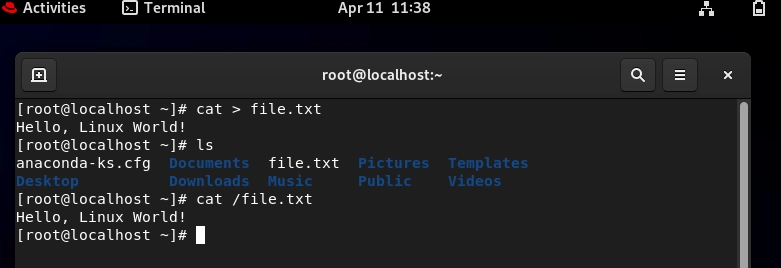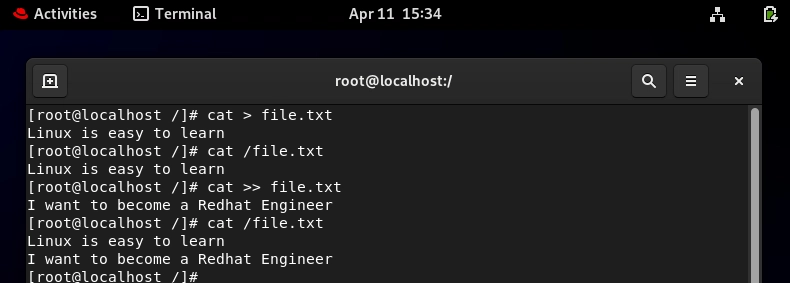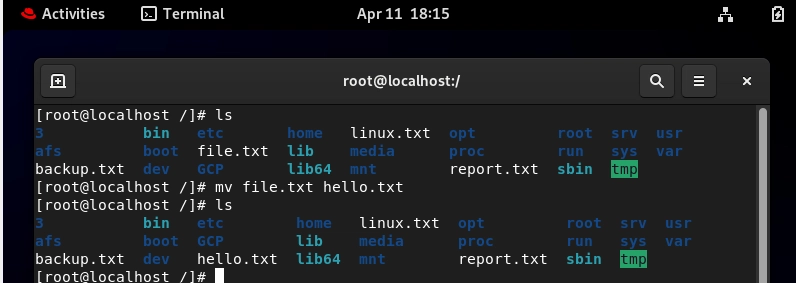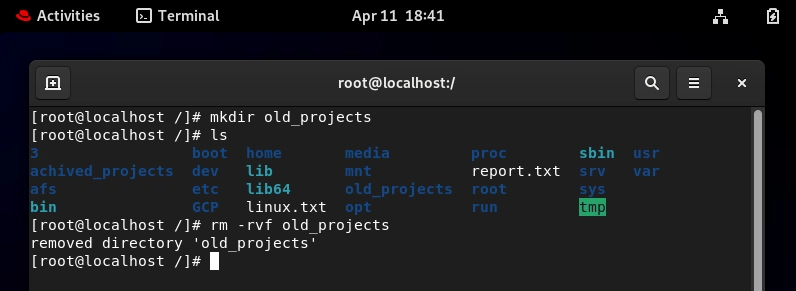Getting Started with Linux Commands: Mastering File and Directory Operations
Linux is known for its powerful command-line utilities that give users granular control over their systems. Whether you're managing files, editing content, or organizing directories, the Linux command line provides unmatched flexibility. In this article, we’ll focus on some essential operations: using the cat command for writing, appending, and replacing file content, as well as creating, copying, moving, and deleting files and directories. With easy-to-follow examples, this guide will help you confidently navigate and manage files in Linux. Table of Contents 1. Introduction to the cat Command Writing to Files Appending to Files Replacing File Content 2. Managing Files Creating Files Copying Files Moving Files Deleting Files 3. Working with Directories Creating Directories Moving Directories Deleting Directories 4. Conclusion [1] Introduction to the cat Command The cat command (short for "concatenate") is primarily used to view the contents of a file. However, it also allows you to write, append, or replace the content of files, making it a versatile tool for file management. Writing to Files To create a new file and write content using cat, use the > operator: cat > file.txt • After running the command, you can type your content. • To save the file, press Ctrl+D. Example: cat > hello.txt Hello, Linux World! Result: Creates a file hello.txt containing the text "Hello, Linux World!" 1.2 Appending to Files To append new content to an existing file, use the >> operator: cat >> file.txt • Add your content, and press Ctrl+D to save. Example: cat >> file.txt Welcome to Linux! Result: Appends "Welcome to Linux!" to the existing content of file.txt. 1.3 Replacing File Content To overwrite and replace all content in a file, use the > operator (like writing): cat > file.txt • This erases the current content and replaces it with the new text. Example: cat > hello.txt This replaces everything in the file. Result: All previous content in hello.txt is replaced. [2] Managing Files File manipulation is a fundamental skill in Linux. Let’s explore the commands to create, copy, move, and delete files. 2.1 Creating Files You can create an empty file using the touch command: touch newfile.txt Example: touch report.txt Result: Creates an empty file named report.txt. 2.2 Copying Files Use the cp command to copy files: cp sourcefile.txt destinationfile.txt Example: cp hello.txt backup_hello.txt Result: Copies hello.txt to backup_hello.txt. 2.3 Moving Files To move or rename a file, use the mv command: mv sourcefile.txt destinationfile.txt Example: Renaming file mv report.txt archive_report.txt Result: Renames report.txt to archive_report.txt. Example: Moving File.txt to afs directory mv file.txt /afs Result: Moves file.txt to /efs directory 2.4 Deleting Files The rm command is used to remove files: rm file.txt Example 1: rm backup_hello.txt Example 2: Delete multiple files rm -rvf backup*.txt Result 1: Deletes the file backup_hello.txt. Result 2: Delete all file that start with backup_hello. [3] Working with Directories Directories help organize files systematically. Let’s learn how to create, move, and delete directories. 3.1 Creating Directories To create a new directory, use the mkdir command: mkdir directory_name Example: mkdir projects Result: Creates a directory named projects. 3.2 Moving Directories You can move or rename directories with the mv command: mv directory_name new_location Example: mv projects archived_project Result: Renames projects to archived_projects. 3.3 Deleting Directories To delete an empty directory, use the rmdir command: rmdir directory_name Example: rmdir old_projects Result: Removes the empty directory old_projects. To delete a directory with content, use the rm command with the -r (recursive) flag: rm -r directory_name Example: rm -r archived_projects Result: Deletes the archived_projects directory and all its contents. [4] Conclusion Linux commands are powerful tools for managing files and directories. The cat command, combined with other basic commands like touch, cp, mv, and rm, allows you to efficiently navigate and manipulate your system. With hands-on practice, these commands will become second nature, helping you perform essential tasks confidently and efficiently. By mastering these commands, you’re building a solid foundation for Linux proficiency, paving the way to tackle advanced topics like scripting, system administration, and automation. Connect with me on LinkedIn To learn more about Linux, cloud and on-prem Infrastructure, DevOps and automation.

Linux is known for its powerful command-line utilities that give users granular control over their systems. Whether you're managing files, editing content, or organizing directories, the Linux command line provides unmatched flexibility. In this article, we’ll focus on some essential operations: using the cat command for writing, appending, and replacing file content, as well as creating, copying, moving, and deleting files and directories. With easy-to-follow examples, this guide will help you confidently navigate and manage files in Linux.
Table of Contents
1. Introduction to the cat Command
- Writing to Files
- Appending to Files
- Replacing File Content
2. Managing Files
- Creating Files
- Copying Files
- Moving Files
- Deleting Files
3. Working with Directories
- Creating Directories
- Moving Directories
- Deleting Directories
4. Conclusion
[1] Introduction to the cat Command
The cat command (short for "concatenate") is primarily used to view the contents of a file. However, it also allows you to write, append, or replace the content of files, making it a versatile tool for file management.
Writing to Files
To create a new file and write content using cat, use the > operator:
cat > file.txt
• After running the command, you can type your content.
• To save the file, press Ctrl+D.
Example:
cat > hello.txt
Hello, Linux World!
Result: Creates a file hello.txt containing the text "Hello, Linux World!"
1.2 Appending to Files
To append new content to an existing file, use the >> operator:
cat >> file.txt
• Add your content, and press Ctrl+D to save.
Example:
cat >> file.txt
Welcome to Linux!
Result: Appends "Welcome to Linux!" to the existing content of file.txt.

1.3 Replacing File Content
To overwrite and replace all content in a file, use the > operator (like writing):
cat > file.txt
• This erases the current content and replaces it with the new text.
Example:
cat > hello.txt
This replaces everything in the file.

Result: All previous content in hello.txt is replaced.
[2] Managing Files
File manipulation is a fundamental skill in Linux. Let’s explore the commands to create, copy, move, and delete files.
2.1 Creating Files
You can create an empty file using the touch command:
touch newfile.txt
Example:
touch report.txt

Result: Creates an empty file named report.txt.
2.2 Copying Files
Use the cp command to copy files:
cp sourcefile.txt destinationfile.txt
Example:
cp hello.txt backup_hello.txt
Result: Copies hello.txt to backup_hello.txt.
2.3 Moving Files
To move or rename a file, use the mv command:
mv sourcefile.txt destinationfile.txt
Example: Renaming file
mv report.txt archive_report.txt
Result: Renames report.txt to archive_report.txt.

Example: Moving File.txt to afs directory
mv file.txt /afs

Result: Moves file.txt to /efs directory
2.4 Deleting Files
The rm command is used to remove files:
rm file.txt
Example 1:
rm backup_hello.txt

Example 2: Delete multiple files
rm -rvf backup*.txt

Result 1: Deletes the file backup_hello.txt.
Result 2: Delete all file that start with backup_hello.
[3] Working with Directories
Directories help organize files systematically. Let’s learn how to create, move, and delete directories.
3.1 Creating Directories
To create a new directory, use the mkdir command:
mkdir directory_name
Example:
mkdir projects
Result: Creates a directory named projects.
3.2 Moving Directories
You can move or rename directories with the mv command:
mv directory_name new_location
Example:
mv projects archived_project

Result: Renames projects to archived_projects.
3.3 Deleting Directories
To delete an empty directory, use the rmdir command:
rmdir directory_name
Example:
rmdir old_projects

Result: Removes the empty directory old_projects.
To delete a directory with content, use the rm command with the -r (recursive) flag:
rm -r directory_name
Example:
rm -r archived_projects
Result: Deletes the archived_projects directory and all its contents.
[4] Conclusion
Linux commands are powerful tools for managing files and directories. The cat command, combined with other basic commands like touch, cp, mv, and rm, allows you to efficiently navigate and manipulate your system. With hands-on practice, these commands will become second nature, helping you perform essential tasks confidently and efficiently.
By mastering these commands, you’re building a solid foundation for Linux proficiency, paving the way to tackle advanced topics like scripting, system administration, and automation.
Connect with me on LinkedIn
To learn more about Linux, cloud and on-prem Infrastructure, DevOps and automation.




























![[Webinar] AI Is Already Inside Your SaaS Stack — Learn How to Prevent the Next Silent Breach](https://blogger.googleusercontent.com/img/b/R29vZ2xl/AVvXsEiOWn65wd33dg2uO99NrtKbpYLfcepwOLidQDMls0HXKlA91k6HURluRA4WXgJRAZldEe1VReMQZyyYt1PgnoAn5JPpILsWlXIzmrBSs_TBoyPwO7hZrWouBg2-O3mdeoeSGY-l9_bsZB7vbpKjTSvG93zNytjxgTaMPqo9iq9Z5pGa05CJOs9uXpwHFT4/s1600/ai-cyber.jpg?#)














































































































































![[The AI Show Episode 144]: ChatGPT’s New Memory, Shopify CEO’s Leaked “AI First” Memo, Google Cloud Next Releases, o3 and o4-mini Coming Soon & Llama 4’s Rocky Launch](https://www.marketingaiinstitute.com/hubfs/ep%20144%20cover.png)




































































































































































































![Rogue Company Elite tier list of best characters [April 2025]](https://media.pocketgamer.com/artwork/na-33136-1657102075/rogue-company-ios-android-tier-cover.jpg?#)








































































_Andreas_Prott_Alamy.jpg?width=1280&auto=webp&quality=80&disable=upscale#)



























































































![What’s new in Android’s April 2025 Google System Updates [U: 4/18]](https://i0.wp.com/9to5google.com/wp-content/uploads/sites/4/2025/01/google-play-services-3.jpg?resize=1200%2C628&quality=82&strip=all&ssl=1)










![Apple Watch Series 10 Back On Sale for $299! [Lowest Price Ever]](https://www.iclarified.com/images/news/96657/96657/96657-640.jpg)
![EU Postpones Apple App Store Fines Amid Tariff Negotiations [Report]](https://www.iclarified.com/images/news/97068/97068/97068-640.jpg)
![Apple Slips to Fifth in China's Smartphone Market with 9% Decline [Report]](https://www.iclarified.com/images/news/97065/97065/97065-640.jpg)





































































































































